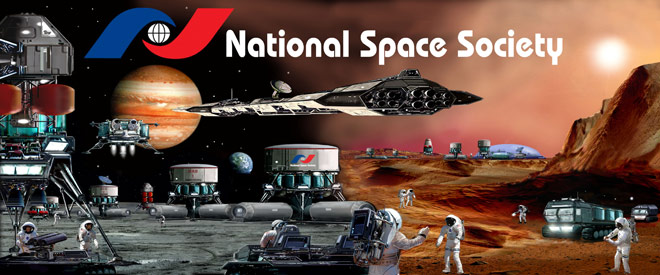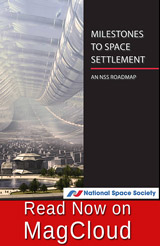- Part I: Introduction
- Part II: Milestones to All Destinations
- Part III: Utilization of Space Technology and Resources
- Part IV: To the Moon
- Part V: To Mars
- Part VI: To the Asteroids
- Part VII: To Orbital Space Settlements
- Part VIII: To the Stars
- Outline of the Roadmap (this page)
- PDF version of entire Roadmap (6 MB)
- Order full color print version

Part II: MILESTONES TO ALL DESTINATIONS
GENERAL BARRIERS TO SPACE SETTLEMENT
- Psychological
- Social
- Economic
MILESTONE 1: Continuous Occupancy in Low Earth Orbit.
Construction of continuously occupied structures in Low Earth Orbit (LEO).
MILESTONE 2: Higher Commercial Launch Rates and Lower Cost to Orbit.
The emergence of a sufficiently large launch market, with more efficient and reliable vehicles with faster turnaround times, or technical and operational improvements such as re-usable vehicles, or both, significantly lowering the cost of access to space. Both higher launch rates and lower vehicle and operational costs will be required.
- Flight Test Demonstrations
- Government Contracting Practices
- Progress in Launch Technology
- Space Tourism
- Commercial Facilities in Orbit
- Space Solar Power
- Other Commercial Space Applications
- Governmental Policies
MILESTONE 3: An Integrated Cislunar Space Transportation System.
In addition to Earth-to-orbit launch systems, the creation of transportation systems and infrastructure in “cislunar space,” i.e., the space between the Earth and the Moon, resulting in regular commerce in cislunar space.
MILESTONE 4: Legal Protection of Property Rights.
Legal protection of property rights enacted to provide prospective off-Earth investors and settlers with the security to take financial risks.
MILESTONE 5: Land Grants or Other Economic Incentives.
Economic incentives, such as “land grants,” to encourage private investment in off-Earth settlements.
MILESTONE 6: Technology for Adequate Self-Sufficiency.
People leaving Earth with the technology and tools needed to settle, survive and prosper without needing constant resupply from Earth.
- Enabling Technologies
- Precursor Missions
Part III. UTILIZATION OF SPACE TECHNOLOGY AND RESOURCES
MILESTONE 7: Applications of Space Technology on and for Earth.
The technologies and techniques developed on the road to space settlement applied widely and benefiting all on Earth.
- In General: Direct Benefits
- In General: Indirect Benefits
- Later: Extra-Terrestrial Raw Materials
- Later: Sunlight from Orbit
MILESTONE 8: Space Solar Power System (SSP).
Establishment of an operational space-based solar power system transmitting the Sun’s energy to Earth.
MILESTONE 9: A Workable Asteroid Protection System.
A system capable of detecting and defending against Earth-approaching asteroids or comets built and standing by to launch on short notice.
- Political and Psychological
- Goal Definition
- Biological
- Uniquely Lunar
MILESTONE 10: Robotic Confirmation of Lunar Resources.
Satellites orbiting the Moon and possibly robotic landers determining the nature and extent of lunar ice and volatile deposits and providing the information necessary to guide the choice of the best sites for a lunar outpost.
- Water and Lunar Volatiles
- Sites for Lunar Outposts
MILESTONE 11: A Lunar Research Facility.
A lunar research facility established to study human habitation, test various equipment and techniques, and conduct lunar investigations.
MILESTONE 12: A Government / Industry Lunar Base.
The initial research facility evolving into a permanently occupied, ever-expanding lunar base, or such a base created at another site using what has been learned from the initial facility, and increasingly performing commercial functions.
- Noncommercial Functions
- Commercial Functions
MILESTONE 13: A True Lunar Settlement.
The lunar base evolving into a permanent settlement, increasingly self-sufficient and increasingly focused on commercial activities.
- Psychological and Political
- Goal Definition
- Biological
- Uniquely Martian
MILESTONE 14: Robotic Exploration of Mars for Local (In Situ) Resources.
Satellites orbiting Mars and robotic landers determining the nature and extent of Martian resources, especially ice, guiding the choice of the best sites for follow-on human missions.
- Scientific Knowledge
- Data for Human Exploration and Outposts
MILESTONE 15: Creation of a Logistics System for Transporting Humans and Cargo to the Martian Surface.
An integrated sustainable system designed and built for transporting humans and cargo from space to the Martian surface, maintaining the crew on the surface, and returning crew and payload safely back to Earth.
- Earth to Mars Transit Transportation Systems
- Earth Orbit to Mars Orbit on a “Cycler”
- Mars Landing Systems
- Earth Return Systems
- Martian “Ferries”
- Orbital Propellant Depot
- Habitation Systems
MILESTONE 16: A Continuously Occupied Multi-Purpose Base.
Following initial crewed missions to identify a suitable location and the particular infrastructure and equipment needed there, establishment of a continuously occupied multi-purpose Mars base.
MILESTONE 17: A True Martian Settlement.
The Martian base evolving into a permanent settlement, increasingly self-sufficient and increasingly focused on commercial activities.
MILESTONE 18: Exploration, Utilization and Settlement of Asteroids.
After robotic identification of suitable asteroids, robotic and human crews following to establish mining bases and habitats for transients, and, eventually, carving out and building permanent human settlements.
Part VII. TO ORBITAL SPACE SETTLEMENTS
MILESTONE 19: Construction of Orbital Space Settlements.
Orbital “cities in space” built from asteroid or lunar materials.
MILESTONE 20: Development of Interstellar Travel.
Eventually, methods developed to enable humans to travel to other stars.
CODA:
Once established throughout the solar system, humans will be truly out of their cradle, and the risk of extinction will be much reduced. When established around multiple stars, the future of humanity will be virtually unbounded. Ad Astra!








